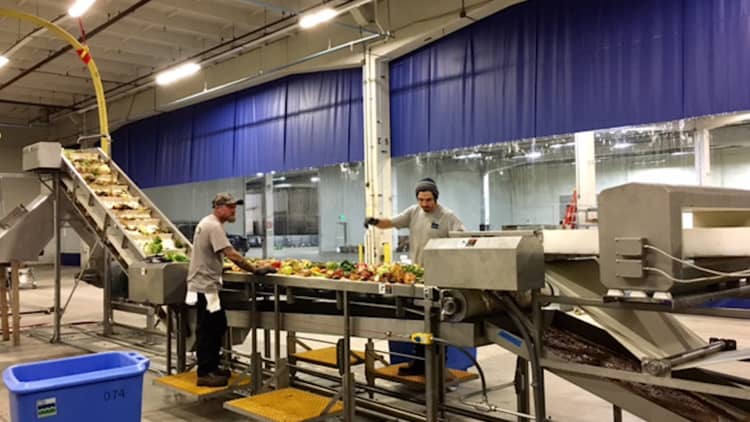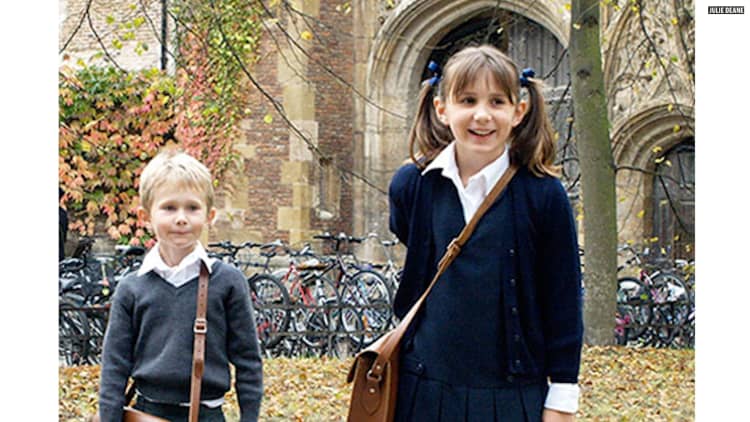In 2007, Julie Deane's 8-year-old daughter, Emily, was being bullied — she'd lost her happy, extroverted personality and came home from school with bruises on her arms. The British mother of two made a promise that day to send her children to private school. But Deane only had £600 ($775) to spare, not the £24,000 ($31,000) it would take to pay tuition.
So the strong-willed Deane decided to invest the money, little as it was, into creating a business to earn the income she needed.
"That's kind of like gamble money. It isn't allocated to anything, so I thought, 'This will be fine, that's what you call seed capital right?'" says Deane, speaking at the Vanity Fair Founders Fair in New York City recently.
It was more than fine: In just over five years, Deane turned that $775 in to a $65 million business, The Cambridge Satchel Company, selling bags to 120 countries all over the world. Celebrities like Taylor Swift, Alexa Chung, Zooey Deschanel and Elle Fanning have worn the satchels.
The Cambridge Satchel Company is born
By 2008, Deane, who was at various times an accountant, stay-at-home mom and university employee, had a simple plan to launch a business; it started with tea in the kitchen. "I thought, obviously, what you do is you go home, and if you are British, you have a cup of tea, and you put the computer on in the kitchen and you get excel up," she says.
As she was brainstorming business ideas, Deane zeroed in on her frustration with the poor quality of school backpacks for her children. When she had gone looking for a traditional satchel, she couldn't find one.
"I am outraged, properly outraged, because the satchel is the most British bag you can ever imagine, everybody had a satchel at school. Nobody was making them. Nobody was making satchels in Britain," she says.
So Deane decided she would be the one to start making quality satchels. "I am really really lucky because I am a very awkward person and so I tend to get really irritated when things don't work properly," she says.
Deane fashioned together a couple old cereal boxes and wrapped them in brown paper for a prototype. She came up with the name quite matter-of-factly. "Well, it's not hard is it. You have got to have a name for your company. I am living in Cambridge. And I sell satchels," she says.
She came up with the logo similarly. She used Microsoft Word's "Paint" function. "Job done. Job done," says Deane.
Deane, who openly expresses bewilderment that launching a business could require expensive consultants and strategists, at the time had no budget to hire a staff — so she enlisted her mom. "Well, the thing is you have got to get somebody who will work really hard, put up with your slightly easily irritated temperament, not expect to be paid. It narrows until you are left with your mother."
From a school supply store in Scotland to New York Fashion week
Artisans were too expensive for Deane's kitchen-table enterprise. So she searched for suppliers on Google and 16 pages back in the results, she came across a school supply store in Scotland claiming to sell satchels. The store didn't have a website. So Deane called the shop to ask where its bags were made.
At first, the owner wouldn't reveal his sources. So Deane called him every half hour with a new question. A day and a half later, tired of the incessant calls, the shop owner relented and gave her his supplier.
Deane had three satchels made in brown leather. Her children modeled them. Deane then taught herself to code in two days with a free Microsoft course so that she could get a website up. "I thought, I am going to need to sell a lot of these things. This is obviously a job for the Internet."
On her home-made website, the Paypal buttons weren't all lined up, admits Deane, but it did the job. She started getting orders (first from friends and family out of pity, she says). The British Satchel Company was officially incorporated by Dec. of 2008.
In 2010, Deane had the idea to send some of her brightest, neon-colored satchels to fashion bloggers to wear at New York Fashion Week. She couldn't afford to go herself. "At the beginning of Cambridge Satchel, I couldn't have come to New York with an economy ticket. It was just not in the budget, everything was going to [private] school fees."
When the lights at fashion week events went down, the neon satchels she sent the bloggers were luminous. The Cambridge Satchel Company got the attention Deane was seeking — perhaps more than she was predicting. She was flooded with 16,000 orders.
At the time, Deane had four small manufacturers that could make 100 satchels each per week. Tops.
How The Cambridge Satchel Company became a manufacturer
To fulfill the 16,000 orders that flooded in, Deane started working with a larger U.K. manufacturer, which at the time was nearly in bankruptcy. After production started, she got a call from one of the employees informing her that the manufacturer was stealing leather from her supply, making copycat bags and selling them at a discount.
"I will not work with somebody that I don't trust," says Deane. She confronted the manufacturer and his brash dismissal of her claims set Deane on a path even she wasn't expecting.
The manufacturer told Deane she had no alternatives but to work with him. "That sort of irritated me a bit," she says. "But then the next line was the real kicker: 'Because you're a stupid woman and you don't know about manufacturing.' And he was so pleased with himself. He turned on his heel and went out the back."
In a near out-of-body experience, Deane heard herself tell the entire staff of the manufacturing factory, who had been watching the confrontation, that she would be starting a factory nearby and if they wanted to work with her, they should email her.
Three weeks later, she had turned a rundown building into a working factory and hired all but two of the rude manufacturer's employees.
In 2013, The Cambridge Satchel Company opened it first retails location. (There are now five, all in the U.K.) By January 2014, The Cambridge Satchel Company was worth £50 million ($65 million), Deane says.
Today, The Cambridge Satchel company is still worth roughly that. According to Dean, it's because she took on investment — and too many executives came with the funding and the bureaucracy slowed the company down.
"I did need an investor, but I needed to stand up more and say I didn't need the really heavy C-suite people they bring in with their enormous team and crushing overheads," says Deane. "But what I allowed them to do was second guess, and take away my confidence in my own business.
"And the really important thing I realize now is that nobody will ever care about my business as much as me."
But Deane is not discouraged. She's had unexpected success so many times.
One of her favorites was in 2012. Impressed by her story, Google featured Deane and The Cambridge Satchel Company as part of its "The web is what you make it" series.
"You do realize that at Google that is what we qualify as a moonshot?" Deane remembers the Google team asking her when they heard her story.
"Luckily I didn't know that, because it just seemed like my daughter needs moving — that's the school, that's how much it costs, and so that's what needs to happen."
See also:
How America's No. 1 small business got to $10 million brewing beer in Hawaii
How a tech entrepreneur ran a 7-figure business from a bus he lived on with a wife and 3 kids
Why this Harvard grad has spent a decade making maxi pads out of banana fibers




